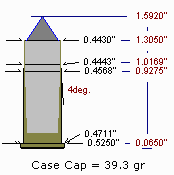Fire Arm |
: Marlin 1894S |
 Click on figure to access ANSI technical cartridge drawing |
Fire Arm |
: Marlin 1894S |
 Click on figure to access ANSI technical cartridge drawing |
A commercial cartridge, an obsolete cartridge, a revivified cartridge, and again, maybe an obsolete cartridge. One of the three surviving cartridges from their 1873 introductions (the other two being the 45-70 and the 45 Colt). Introduced as an additional chambering for the m1873 lever gun a few month after the gun's initial introduction in 45-70. Initially known as the 44 Win. The cartridge and the m73 were instant successes: over 100,000 m73's were sold in 44 Win, from 1873 thru 1883. With the chambering of the 44-40 in the Colt peacemaker of 1873, in 1874, the 44-40 became the first viable single cartridge for both a wheel gun and a lever arm. The cartridge has been chambered by all major manufacturers at one time.
Ballistically, the 44-40 is a multi-personality cartridge. If loaded as initially, then it's a 13k CUP load, launching a 200 gr FN, from atop 40 grs of FFg, at 1300 fps. This load is usable in all rifles and revolvers. If one pushes the pressure up toward 22k CUP, then the cartridge becomes only usable in m1894 soft steel lever guns, or stronger. If in a modern m94, then the cartridge can be loaded to 30k PSI, producing 44 Rem Mag type energies. Ballistically, the cartridge was offered as an upgrade to the 44 Henry rimfire and its 28 gr. charges. In 1914 smokeless powder based "high velocity" loads were developed and offered by Win; these increased the standard 200 gr FN to 1569 fps. These loads were for lever guns only.
Of the 1873 cartridges, the 44-40 having been revivified once, is probably now on its way out forever. Marlin offered the 44-40 in their m1894 rifle, ca. 1979, since discontinued. Otherwise, the 44-40 was last chambered for american rifles in 1937, for revolvers in 1942. (Common in Australia until the 1970s.) Although used for decades as a deer cartridge, when loaded at m1873 levels, it only produces between 357 Mag and 44 Special energies.
Of note: pre-WWII brass was of balloon head design and offered 2.5-3 grs. greater capacity vs today's solid head brass - if early full loads are to be used, they must be scaled down to address this reduced case capacity. Also of note: the original m73 sported 1:38 rifling to cope with 44-40 rainbow trajectories, modern reproductions tend to sport 1:18 rifling to cope with SWC-L bullets, but make long range shooting impossible.
Nominal bullet diameter (today) is .427", initially in m73, .424". Brass is commercially available. ANSI lists the maximum operating pressure as 13k CUP. Reloading dies are available from RCBS.